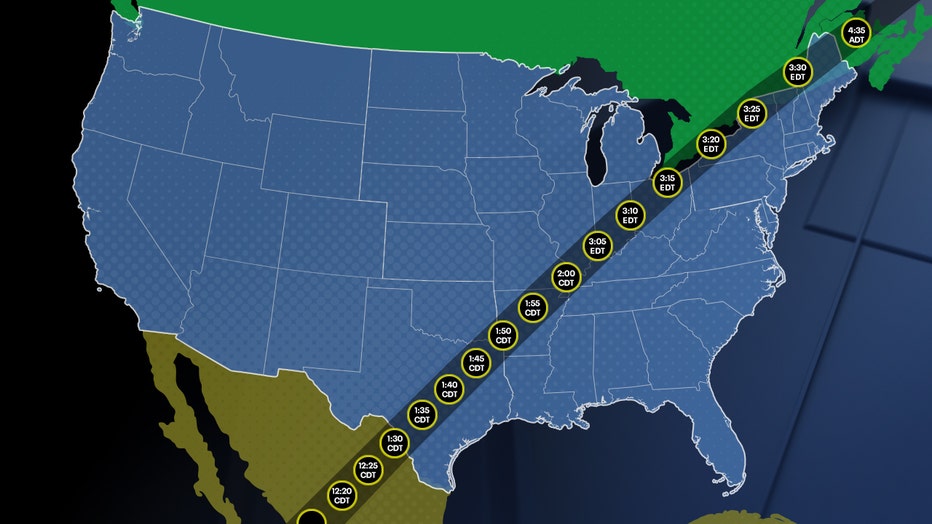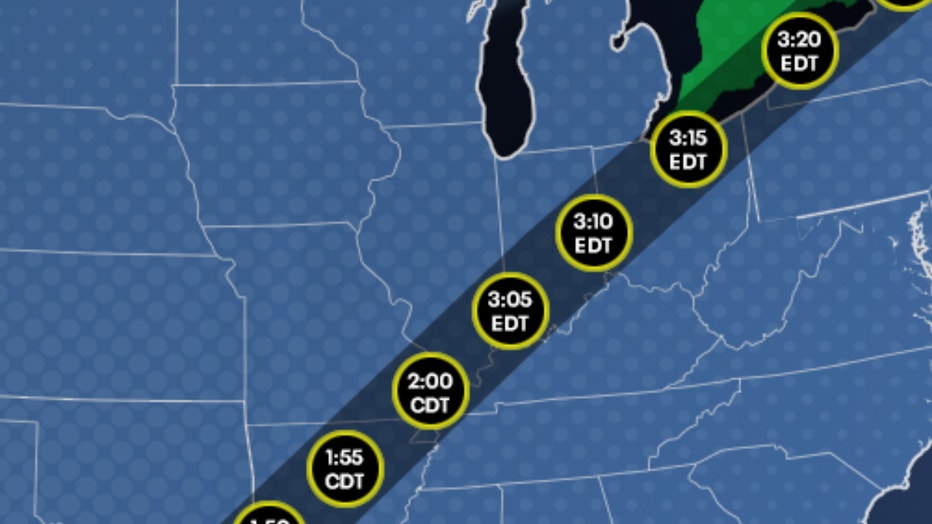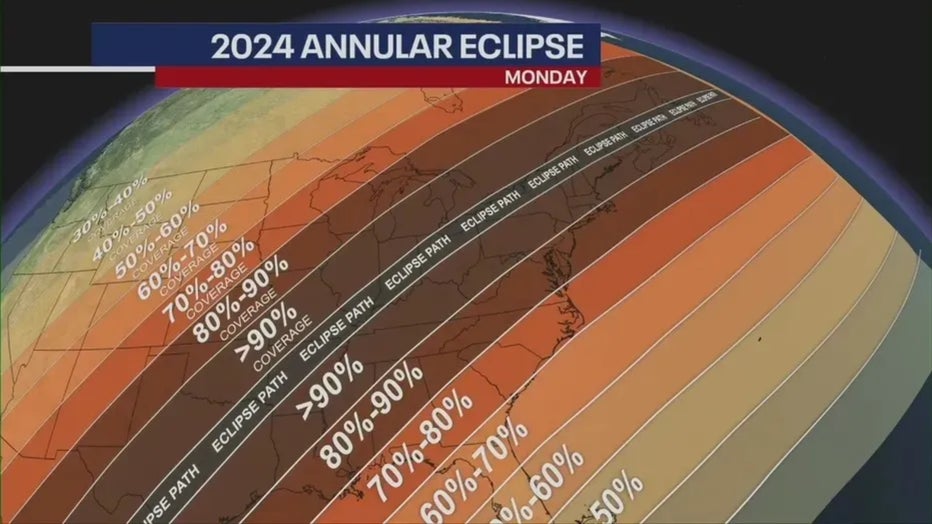Chicago solar eclipse map: Path through Illinois, peak times on April 8
CHICAGO - What is the path of totality of the 2024 total solar eclipse? When will it peak in Chicago and southern Illinois?
Check out the maps below to help you prepare for the moment the moon blocks the sun on April 8.
US path of totality and interactive map

Projected path and time of totality for the 2024 total solar eclipse over the U.S. A partial eclipse will be visible throughout all 48 contiguous U.S. states.
The path of totality, where the moon completely covers the sun, will move from Texas to Maine throughout the afternoon on Monday. The event begins at the Texas-Mexico border around 12:10 p.m. Central Daylight Time and ends after it leaves northern Maine around 4:40 p.m. Eastern Daylight Time.
Click here for NASA's mobile-friendly interactive map
Illinois path of totality

Projected path and time of totality for the 2024 total solar eclipse over Illinois.
More than one million people in southern Illinois live in the path of totality. Peak totality for the area will begin to occur around 1:58 p.m. Central Daylight Time.
The eclipse's trajectory, moving from southwest to northeast, will encompass cities like Cairo, Olive Branch, Grand Tower, Red Bud, Carbondale, Mount Vernon, Harrisburg, and Fairfield before reaching communities near the Indiana border such as Olney and Robinson. They all lie in the path of totality and will be plunged into darkness for up to a few minutes.
READ MORE: Where to find free solar eclipse glasses before April 8
Total and annular eclipse coverage map

(Source: WNYW)
The path of totality is 115 miles wide and spans more than a dozen states. The farther you are from the path, the less the sun will appear to be blocked.
Still, all 48 states in the contiguous United States should see at least a partial eclipse.
What time will the solar eclipse happen in Chicago?
The exact timing of the eclipse depends on where you are viewing it. Chicago and the surrounding suburbs will experience a partial eclipse, with an estimated 94% totality.
The partial eclipse will be visible in Chicago from 12:51 p.m. to 3:22 p.m., reaching peak totality at 2:07 p.m. Since Chicagoland is not in the path of totality, it will not be safe to view the eclipse without eclipse glasses or other tools.
Chicago suburbs like Aurora, Elgin, Crystal Lake, Joliet, Naperville and Kankakee will see peak totality around 2:06 p.m., whereas in Schaumburg and Waukegan it's 2:07 p.m.
The last time Chicagoland was this close to the path of totality for a total solar eclipse was in 2017, when the totality reached 90% — and before that the area hadn't seen one since 1869!
What time will the solar eclipse happen in these Illinois cities?
Grand Tower
- Start of partial eclipse: 12:42 p.m. CDT
- Start of total eclipse: 1:58:45 p.m.
- End of total eclipse: 3:17 p.m.
- Duration of totality: 4 minutes 7 seconds
Carbondale
- Start of partial eclipse: 12:43 p.m.
- Start of total eclipse: 1:59:15 p.m.
- End of total eclipse: 3:18 p.m.
- Duration of totality: 4 minutes 10 seconds
Vienna
- Start of partial eclipse: 12:43 p.m.
- Start of total eclipse: 1:59:38 p.m.
- End of total eclipse: 3:18 p.m.
- Duration of totality: 3 minutes 45 seconds
Harrisburg
- Start of partial eclipse: 12:44 p.m.
- Start of total eclipse: 2:00:24 p.m.
- End of total eclipse: 3:18 p.m.
- Duration of totality: 3 minutes 56 seconds
Tips for viewing the last total solar eclipse for 20 years
Mother Nature is putting together quite a show for all to see on April 8. It’s going to be the last total solar eclipse that we will see for the next 20 years and Illinois has some of the best seats to offer.
Mount Vernon
- Start of partial eclipse: 12:44 p.m.
- Start of total eclipse: 2:00:35 p.m.
- End of total eclipse: 3:18 p.m.
- Duration of totality: 3 minutes 41 seconds
Carmi
- Start of partial eclipse: 12:45 p.m.
- Start of total eclipse: 2:01:18 p.m.
- End of total eclipse: 3:19 p.m.
- Duration of totality: 4 minutes 2 seconds
Fairfield
- Start of partial eclipse: 12:45 p.m.
- Start of total eclipse: 2:01:19 p.m.
- End of total eclipse: 3:19 p.m.
- Duration of totality: 4 minutes 2 seconds
Olney
- Start of partial eclipse: 12:46 p.m.
- Start of total eclipse: 2:02:13
- End of total eclipse: 3:20 p.m.
- Duration of totality: 3 minutes 48 seconds
Robinson
- Start of partial eclipse: 12:47 p.m.
- Start of total eclipse: 2:03:06 p.m.
- End of total eclipse: 3:20 p.m.
- Duration of totality: 3 minutes 39 seconds
Click here for NASA's mobile-friendly interactive map
What Will I See During the Eclipse?
If you are in the path of totality:
The moon will appear to completely block the sun for as long as seven and a half minutes. Daytime will turn into near night during that time and the sun’s corona – the outer rays – may be visible.
If you are not far from the path of totality:
The moon will appear to block most of the sun. It will still become noticeably darker; daylight will become more like twilight.
If you are well outside the path of totality:
You’ll notice a chunk of the sun is being blocked. The farther away you are, the smaller the moon’s bite will appear to be. In Seattle and Portland, Oregon, about as far away as you can get in the continental U.S., one-third of the sun will be swallowed.
Where else will the total solar eclipse occur?
According to Eclipse2024.org, the unincorporated village of Eidson Road, near the U.S.-Mexico border will be the first to see the phenomenon. Here's the timing of each state's total solar eclipse:
- Dallas, Texas around 1:40 p.m. (CDT)
- Idabel, Oklahoma around 1:45 p.m. (CDT)
- Little Rock, Arkansas around 1:51 p.m. (CDT)
- Poplar Bluff, Missouri around 1:56 p.m. (CDT)
- Carbondale, Illinois at 1:59 p.m. (CDT)
- Paducah, Kentucky around 2 p.m. (CDT)
- Evansville, Indiana at 2:02 p.m. (CDT)
- Cleveland, Ohio at 3:13 p.m. (EDT)
- Erie, Pennsylvania at 3:16 p.m. (EDT)
- Buffalo, New York at 3:18 p.m. (EDT)
- Burlington, Vermont at 3:26 p.m. (EDT)
- Lancaster, New Hampshire at 3:27 p.m. (EDT)
- Caribou, Maine at 3:32 p.m. (EDT)
Future Total Solar Eclipses
Following the April 8, 2024, event, the next total solar eclipse in parts of the U.S. won't occur until 2044. Subsequently, an eclipse in August 2045 will cover a more extensive portion of the U.S.
RELATED LINKS
- 2024 Total Eclipse: Where & When
- Illinois Eclipse Events
- 16 of the coolest places to watch the solar eclipse
- Where to find free solar eclipse glasses before April 8
- What an eclipse looks like from space, and why you should see one (from Earth)


